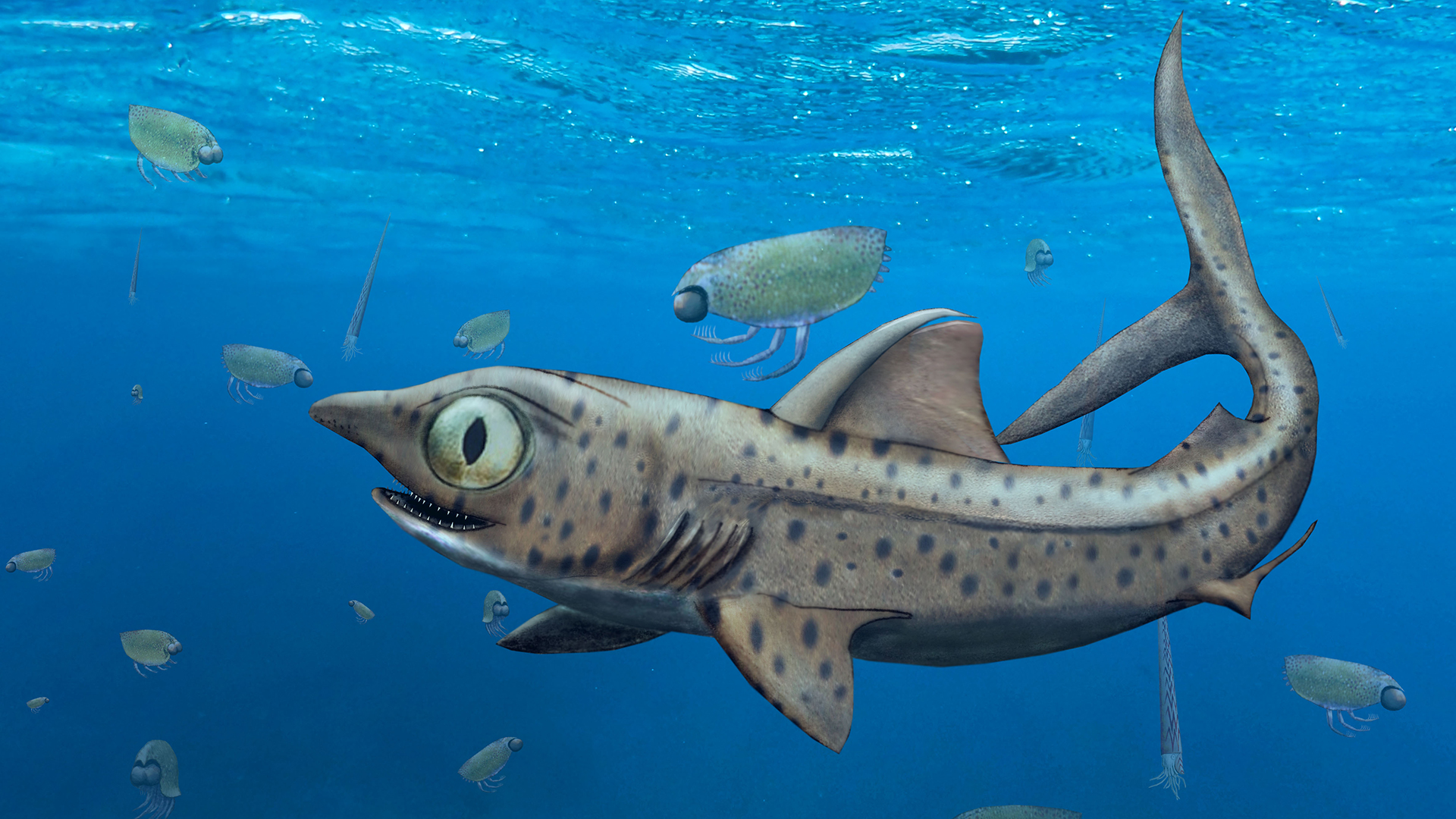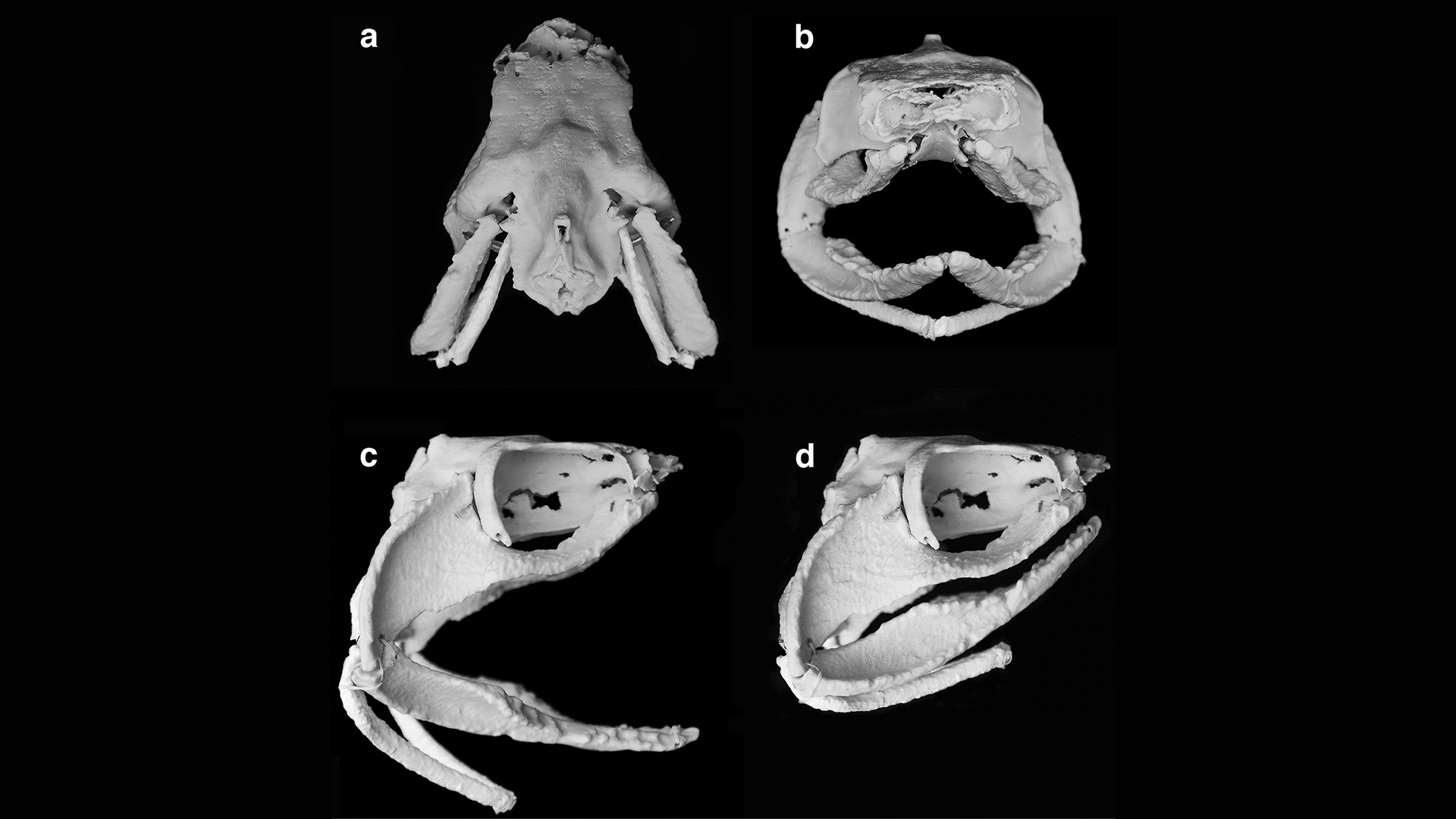Wide-eyed prehistoric shark hid its sharpest teeth in nightmare jaws
This predator's toothy grin came with a horrific twist.

Imagine you're a fish swimming through the ocean millions of years ago, when a shark lunges at you, gaping its mouth to bite. The horror of your predicament increases as the predator's lower jaw also stretches downward on both sides, so that newer, sharper teeth that were previously lying flat along the side of the jaw now curve up.
Scientists recently discovered this nightmarish trait in a fossil of a 370 million-year-old shark that once inhabited waters near what is now Morocco. The previously undescribed species, dubbed Ferromirum oukherbouchi, had a jaw that rotated inward when the mouth was closed, and outward when the mouth was open.
Unlike modern sharks, in which worn-down teeth are constantly displaced by new teeth, this shark sprouted its newer teeth in a row on the inside of the jaw, next to the older teeth. As the new teeth grew, they curved toward the shark's tongue. When the shark opened its mouth, cartilage at the back of the jaw flexed so that the sides of the jaw "folded" down and newer teeth rotated upward, allowing the shark to bite into its prey with as many teeth as possible, according to a new study.
Related: 8 weird facts about sharks
F. oukherbouchi had a small, slender body measuring about 13 inches (33 centimeters) long, and its snout was triangular and short; its eyes were unusually large, with the orbits taking up about 30% of the braincase's total length, the scientists reported. The shark's jaw and hyoid arch — cartilage structures behind the jaw — were preserved in 3D, offering intriguing clues about jaw structure and function in ancient sharks.
Because the jaw was so well-preserved, the researchers were able to scan it with computed X-ray tomography (CT) and then digitally model it in 3D to conduct mechanical tests. They found that the shark's jaw wasn't fused down the center, so it was able to bend outward along this flexible seam when the mouth was open.
"Through this rotation, the younger, larger and sharper teeth, which usually pointed toward the inside of the mouth, were brought into an upright position. This made it easier for animals to impale their prey," said lead study author Linda Frey, a doctoral candidate with the Institut für Paläontologie und Paläontologisches Museum at the University of Zurich in Switzerland.
Sign up for the Live Science daily newsletter now
Get the world’s most fascinating discoveries delivered straight to your inbox.

When the shark's jaw closed, sea water rushed into its mouth to push the prey down toward the throat. At the same time, the closing jaw rotated the teeth inward to immobilize and trap the shark's meal, Frey said in a statement. This pattern of jaw movement is unlike anything known in any living fish, the scientists wrote in the study.
Prior studies of jaws in early chondrichthyans — the group that includes sharks, skates and rays — were hampered by the poor preservation of fossils. But just a few well-preserved 3D fossils like this one could help paleontologists piece together a clearer picture of how ancient sharks' jaws performed in 3D, even if most of the existing fossil specimens are incomplete or "flattened," according to the study.
Understanding how this specialized combination of jaw motion and tooth placement was distributed across the shark family tree could also explain how the assembly line of ever-growing tooth clusters in modern sharks evolved, the researchers reported.
The findings were published online Nov. 17 in the journal Communications Biology.
Originally published on Live Science.

Mindy Weisberger is an editor at Scholastic and a former Live Science channel editor and senior writer. She has reported on general science, covering climate change, paleontology, biology and space. Mindy studied film at Columbia University; prior to Live Science she produced, wrote and directed media for the American Museum of Natural History in New York City. Her videos about dinosaurs, astrophysics, biodiversity and evolution appear in museums and science centers worldwide, earning awards such as the CINE Golden Eagle and the Communicator Award of Excellence. Her writing has also appeared in Scientific American, The Washington Post and How It Works Magazine. Her book "Rise of the Zombie Bugs: The Surprising Science of Parasitic Mind Control" will be published in spring 2025 by Johns Hopkins University Press.










